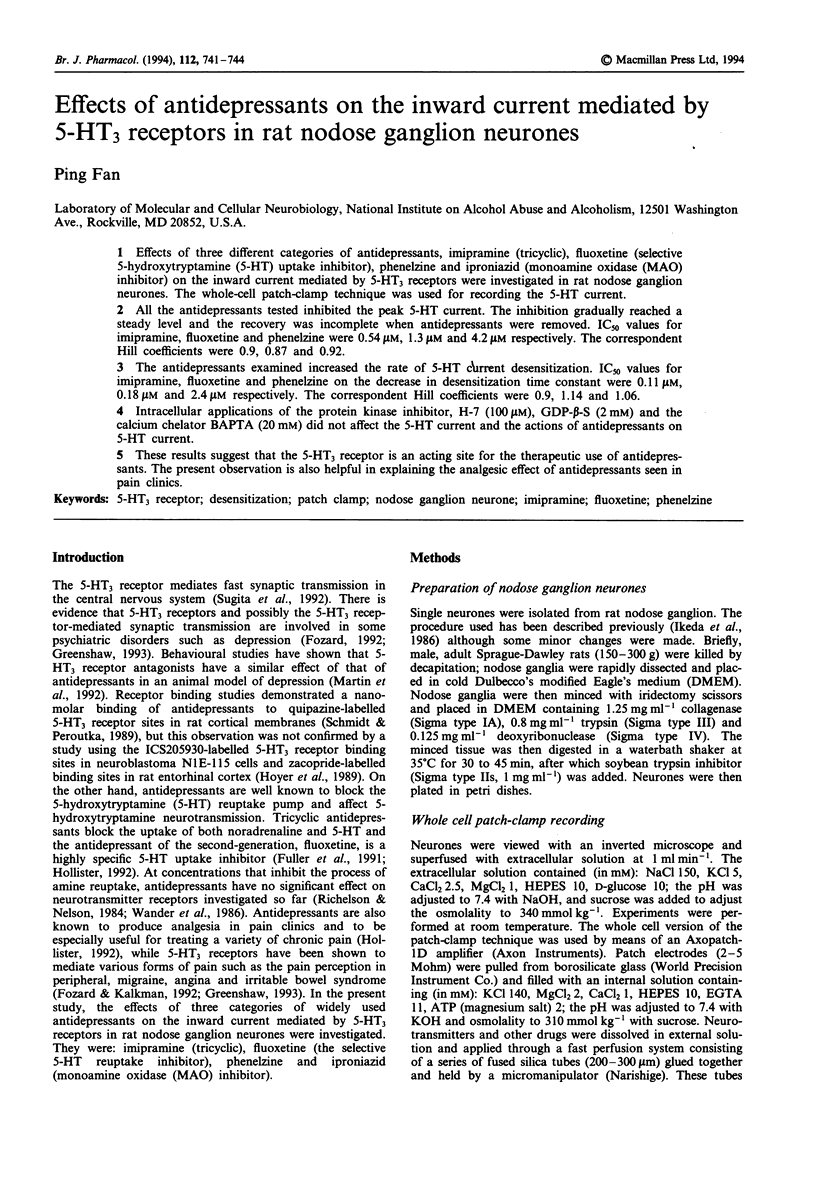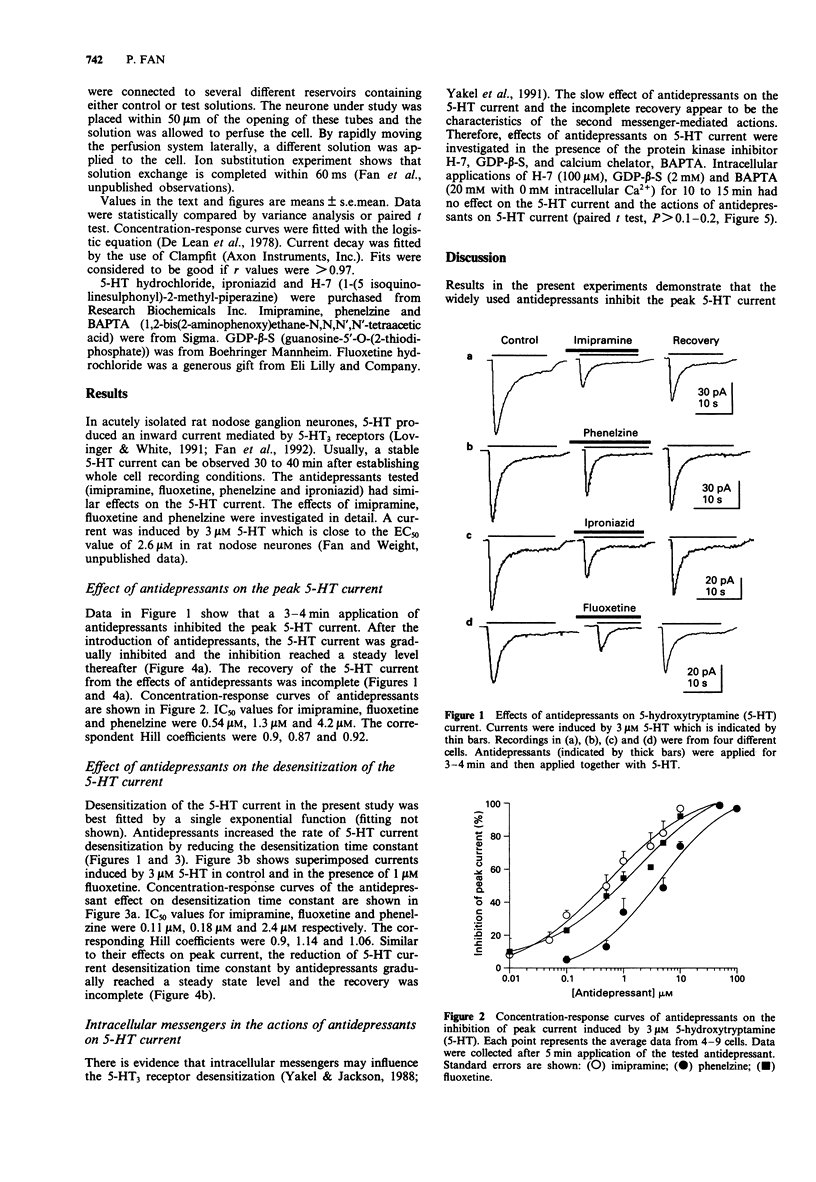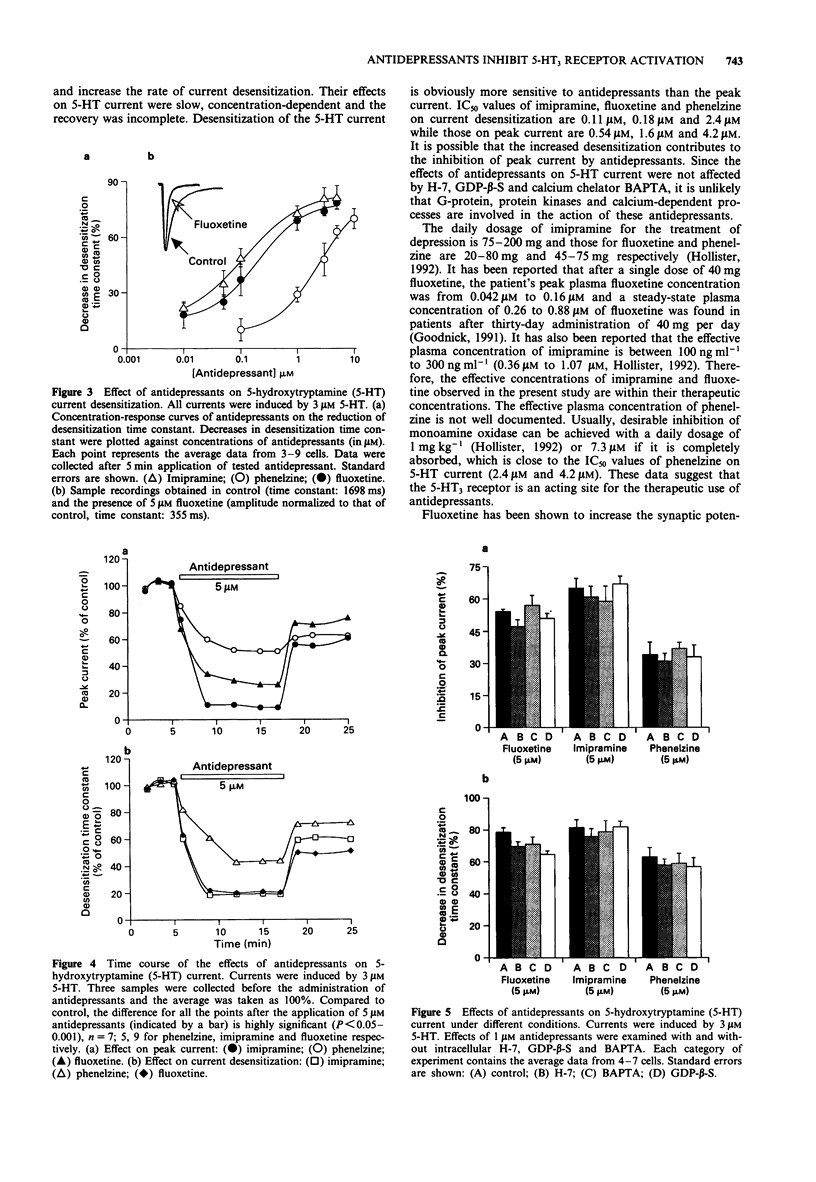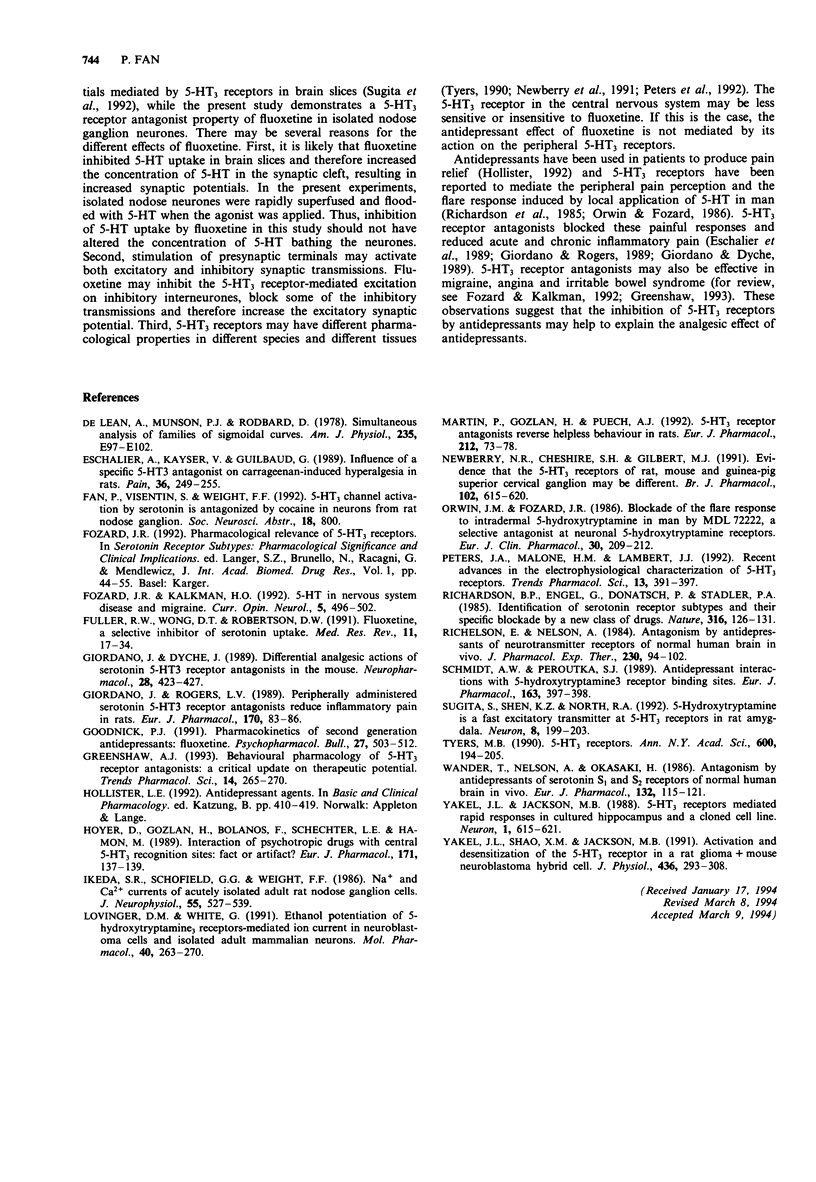Abstract
1. Effects of three different categories of antidepressants, imipramine (tricyclic), fluoxetine (selective 5-hydroxytryptamine (5-HT) uptake inhibitor), phenelzine and iproniazid (monoamine oxidase (MAO) inhibitor) on the inward current mediated by 5-HT3 receptors were investigated in rat nodose ganglion neurones. The whole-cell patch-clamp technique was used for recording the 5-HT current. 2. All the antidepressants tested inhibited the peak 5-HT current. The inhibition gradually reached a steady level and the recovery was incomplete when antidepressants were removed. IC50 values for imipramine, fluoxetine and phenelzine were 0.54 microM, 1.3 microM and 4.2 microM respectively. The correspondent Hill coefficients were 0.9, 0.87 and 0.92. 3. The antidepressants examined increased the rate of 5-HT current desensitization. IC50 values for imipramine, fluoxetine and phenelzine on the decrease in desensitization time constant were 0.11 microM, 0.18 microM and 2.4 microM respectively. The correspondent Hill coefficients were 0.9, 1.14 and 1.06. 4. Intracellular applications of the protein kinase inhibitor, H-7 (100 microM), GDP-beta-S (2 mM) and the calcium chelator BAPTA (20 mM) did not affect the 5-HT current and the actions of antidepressants on 5-HT current. 5. These results suggest that the 5-HT3 receptor is an acting site for the therapeutic use of antidepressants. The present observation is also helpful in explaining the analgesic effect of antidepressants seen in pain clinics.
Full text
PDF



Selected References
These references are in PubMed. This may not be the complete list of references from this article.
- DeLean A., Munson P. J., Rodbard D. Simultaneous analysis of families of sigmoidal curves: application to bioassay, radioligand assay, and physiological dose-response curves. Am J Physiol. 1978 Aug;235(2):E97–102. doi: 10.1152/ajpendo.1978.235.2.E97. [DOI] [PubMed] [Google Scholar]
- Eschalier A., Kayser V., Guilbaud G. Influence of a specific 5-HT3 antagonist on carrageenan-induced hyperalgesia in rats. Pain. 1989 Feb;36(2):249–255. doi: 10.1016/0304-3959(89)90030-4. [DOI] [PubMed] [Google Scholar]
- Fozard J. R., Kalkman H. O. 5-HT in nervous system disease and migraine. Curr Opin Neurol Neurosurg. 1992 Aug;5(4):496–502. [PubMed] [Google Scholar]
- Fuller R. W., Wong D. T., Robertson D. W. Fluoxetine, a selective inhibitor of serotonin uptake. Med Res Rev. 1991 Jan;11(1):17–34. doi: 10.1002/med.2610110103. [DOI] [PubMed] [Google Scholar]
- Giordano J., Dyche J. Differential analgesic actions of serotonin 5-HT3 receptor antagonists in the mouse. Neuropharmacology. 1989 Apr;28(4):423–427. doi: 10.1016/0028-3908(89)90040-3. [DOI] [PubMed] [Google Scholar]
- Giordano J., Rogers L. V. Peripherally administered serotonin 5-HT3 receptor antagonists reduce inflammatory pain in rats. Eur J Pharmacol. 1989 Oct 24;170(1-2):83–86. doi: 10.1016/0014-2999(89)90137-4. [DOI] [PubMed] [Google Scholar]
- Goodnick P. J. Pharmacokinetics of second generation antidepressants: fluoxetine. Psychopharmacol Bull. 1991;27(4):503–512. [PubMed] [Google Scholar]
- Greenshaw A. J. Behavioural pharmacology of 5-HT3 receptor antagonists: a critical update on therapeutic potential. Trends Pharmacol Sci. 1993 Jul;14(7):265–270. doi: 10.1016/0165-6147(93)90128-7. [DOI] [PubMed] [Google Scholar]
- Hoyer D., Gozlan H., Bolanos F., Schechter L. E., Hamon M. Interaction of psychotropic drugs with central 5-HT3 recognition sites: fact or artifact? Eur J Pharmacol. 1989 Nov 14;171(1):137–139. doi: 10.1016/0014-2999(89)90438-x. [DOI] [PubMed] [Google Scholar]
- Ikeda S. R., Schofield G. G., Weight F. F. Na+ and Ca2+ currents of acutely isolated adult rat nodose ganglion cells. J Neurophysiol. 1986 Mar;55(3):527–539. doi: 10.1152/jn.1986.55.3.527. [DOI] [PubMed] [Google Scholar]
- Lovinger D. M., White G. Ethanol potentiation of 5-hydroxytryptamine3 receptor-mediated ion current in neuroblastoma cells and isolated adult mammalian neurons. Mol Pharmacol. 1991 Aug;40(2):263–270. [PubMed] [Google Scholar]
- Martin P., Gozlan H., Puech A. J. 5-HT3 receptor antagonists reverse helpless behaviour in rats. Eur J Pharmacol. 1992 Feb 25;212(1):73–78. doi: 10.1016/0014-2999(92)90074-e. [DOI] [PubMed] [Google Scholar]
- Newberry N. R., Cheshire S. H., Gilbert M. J. Evidence that the 5-HT3 receptors of the rat, mouse and guinea-pig superior cervical ganglion may be different. Br J Pharmacol. 1991 Mar;102(3):615–620. doi: 10.1111/j.1476-5381.1991.tb12221.x. [DOI] [PMC free article] [PubMed] [Google Scholar]
- Orwin J. M., Fozard J. R. Blockade of the flare response to intradermal 5-hydroxytryptamine in man by MDL 72.222, a selective antagonist at neuronal 5-hydroxytryptamine receptors. Eur J Clin Pharmacol. 1986;30(2):209–212. doi: 10.1007/BF00614305. [DOI] [PubMed] [Google Scholar]
- Peters J. A., Malone H. M., Lambert J. J. Recent advances in the electrophysiological characterization of 5-HT3 receptors. Trends Pharmacol Sci. 1992 Oct;13(10):391–397. doi: 10.1016/0165-6147(92)90119-q. [DOI] [PubMed] [Google Scholar]
- Richardson B. P., Engel G., Donatsch P., Stadler P. A. Identification of serotonin M-receptor subtypes and their specific blockade by a new class of drugs. Nature. 1985 Jul 11;316(6024):126–131. doi: 10.1038/316126a0. [DOI] [PubMed] [Google Scholar]
- Richelson E., Nelson A. Antagonism by antidepressants of neurotransmitter receptors of normal human brain in vitro. J Pharmacol Exp Ther. 1984 Jul;230(1):94–102. [PubMed] [Google Scholar]
- Schmidt A. W., Peroutka S. J. Antidepressant interactions with 5-hydroxytryptamine3 receptor binding sites. Eur J Pharmacol. 1989 Apr 25;163(2-3):397–398. doi: 10.1016/0014-2999(89)90215-x. [DOI] [PubMed] [Google Scholar]
- Sugita S., Shen K. Z., North R. A. 5-hydroxytryptamine is a fast excitatory transmitter at 5-HT3 receptors in rat amygdala. Neuron. 1992 Jan;8(1):199–203. doi: 10.1016/0896-6273(92)90121-s. [DOI] [PubMed] [Google Scholar]
- Tyers M. B. 5-HT3 receptors. Ann N Y Acad Sci. 1990;600:194–205. doi: 10.1111/j.1749-6632.1990.tb16882.x. [DOI] [PubMed] [Google Scholar]
- Wander T. J., Nelson A., Okazaki H., Richelson E. Antagonism by antidepressants of serotonin S1 and S2 receptors of normal human brain in vitro. Eur J Pharmacol. 1986 Dec 16;132(2-3):115–121. doi: 10.1016/0014-2999(86)90596-0. [DOI] [PubMed] [Google Scholar]
- Yakel J. L., Jackson M. B. 5-HT3 receptors mediate rapid responses in cultured hippocampus and a clonal cell line. Neuron. 1988 Sep;1(7):615–621. doi: 10.1016/0896-6273(88)90111-0. [DOI] [PubMed] [Google Scholar]
- Yakel J. L., Shao X. M., Jackson M. B. Activation and desensitization of the 5-HT3 receptor in a rat glioma x mouse neuroblastoma hybrid cell. J Physiol. 1991 May;436:293–308. doi: 10.1113/jphysiol.1991.sp018551. [DOI] [PMC free article] [PubMed] [Google Scholar]


